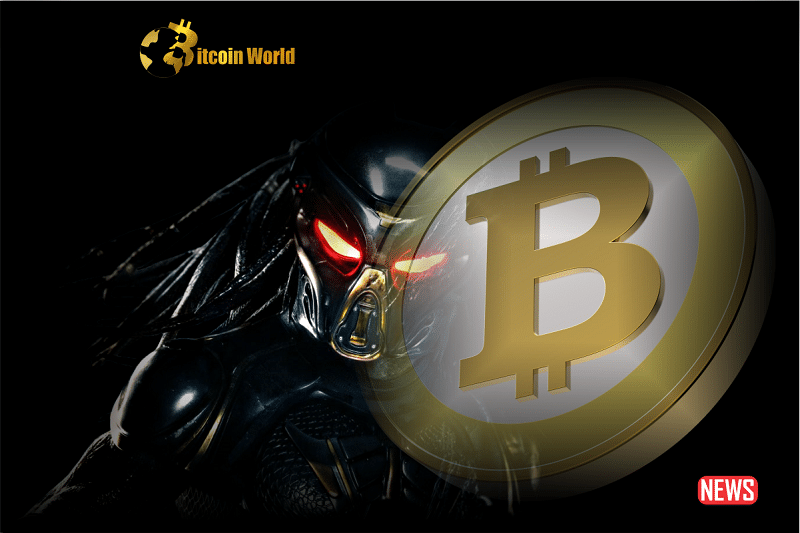Ever noticed a sudden traffic jam on the digital highway? Well, that’s kind of what happened with Bitcoin recently! Over the weekend, the crypto-sphere was buzzing about a significant spike in Bitcoin transaction fees, reaching a whopping $28,376 at one point, coupled with a massive backlog of unconfirmed transactions. Naturally, alarm bells started ringing, with some speculating about a potential Denial of Service (DoS) attack on the network. But is that really what’s going on?
Decoding the Bitcoin Fee Frenzy: What Happened?
Before we jump to conclusions about malicious attacks, let’s break down what actually transpired. While the initial surge caused concern, level-headed Bitcoin analysts stepped in to calm the nerves. According to BitInfoCharts, the average Bitcoin transaction fee is currently around $19.20 (approximately 0.00068 BTC). However, the sheer volume of transactions waiting to be processed, as tracked by Mempool Space, peaked at a staggering 459,341.
The Block Reward Flip: A Rare Occurrence
Here’s a fascinating tidbit: On May 7th, the total fees paid for transactions within a block actually exceeded the standard block reward of 6.25 BTC. This is a noteworthy event because the block reward, which incentivizes miners in the proof-of-work system, is typically the larger component. Think of it like this:
- Normal Scenario: Miners receive a fixed block reward (currently 6.25 BTC) + transaction fees.
- High Demand Scenario: When network demand surges, the competition to get transactions included in a block intensifies, driving up transaction fees. This can temporarily make the total fees greater than the block reward.
Business analysts point out that this phenomenon hasn’t been seen since 2017, highlighting the unusual level of activity. For instance, one block recorded fees of 6.76 Bitcoin, and another, block 788695, had fees of 6.7 Bitcoin. Thankfully, according to Mempool Space Explorer, the frenzy has subsided somewhat, and fees have since dipped below the block reward. The estimated cost for processing the next block is around 4.51 BTC in fees.
Why the Sudden Surge? Blame it on the Ordinals!
So, what fueled this dramatic increase in activity? The prevailing theory points to the growing popularity of Ordinals inscriptions. These are essentially a way to inscribe data onto individual satoshis (the smallest unit of Bitcoin), allowing for the creation of Bitcoin-based NFTs and other digital artifacts. Data from Glassnode indicates that on May 7th, a record-breaking 75% of all Bitcoin on-chain transactions utilized Taproot, the technology that makes Ordinals possible.
DoS Attack or Just Plain Popularity?
The initial reaction on Crypto Twitter leaned towards a potential DoS attack. A DoS attack aims to overwhelm a network with traffic, making it unusable. However, seasoned Bitcoin analysts quickly countered this narrative, emphasizing that the congestion was likely due to genuine demand. As one prominent voice, “0xfoobar,” with a significant following, succinctly put it: “Bitcoin mempool finally sees some use, and the maxis are framing it as a DoS attack on the network. The most straightforward scenarios, such as ‘Bitcoin becomes popular, and people are willing to pay to use it,’ have not even been considered by them.”
Binance Halts Bitcoin Transactions (Again)

Adding another layer to the story, Binance, the world’s largest cryptocurrency exchange, had to temporarily suspend Bitcoin withdrawals and deposits on May 8th, citing the “large volume of pending transactions.” Interestingly, this wasn’t an isolated incident; Binance had already paused BTC transactions once in the preceding 12 hours. This highlights the real-world impact of network congestion on even the biggest players in the crypto space.
Key Takeaways: Understanding Bitcoin Network Dynamics
- Demand Drives Fees: High demand for block space directly translates to higher transaction fees. This is a fundamental aspect of Bitcoin’s market-based fee system.
- Ordinals Impact: The rise of Ordinals inscriptions is a significant factor contributing to increased on-chain activity and network congestion.
- Not Necessarily an Attack: While sudden surges can raise concerns, it’s crucial to analyze the data and consider simpler explanations like increased user adoption and innovative use cases.
- Binance’s Experience: Even major exchanges are affected by network congestion, highlighting the need for scalability solutions within the Bitcoin ecosystem.
Looking Ahead: Scalability and Bitcoin’s Future
The recent events serve as a reminder of the ongoing discussions surrounding Bitcoin’s scalability. While technologies like Taproot enable new functionalities, they can also contribute to temporary congestion. Solutions like the Lightning Network, a layer-2 scaling solution, aim to address these issues by enabling faster and cheaper off-chain transactions. The debate about the best path forward for Bitcoin’s evolution continues, but one thing is clear: increased adoption brings both opportunities and challenges.
In Conclusion: A Sign of Growth, Not Necessarily Alarm
While the spike in Bitcoin transaction fees and the resulting network congestion might have caused some initial jitters, the prevailing sentiment among analysts suggests this is more a symptom of Bitcoin’s increasing popularity and the innovative uses being built upon it, rather than a malicious attack. The temporary inconvenience experienced by users and exchanges underscores the importance of ongoing efforts to enhance Bitcoin’s scalability. Ultimately, the increased activity, even with its associated fees, can be seen as a sign of a vibrant and evolving Bitcoin ecosystem.
Disclaimer: The information provided is not trading advice, Bitcoinworld.co.in holds no liability for any investments made based on the information provided on this page. We strongly recommend independent research and/or consultation with a qualified professional before making any investment decisions.


